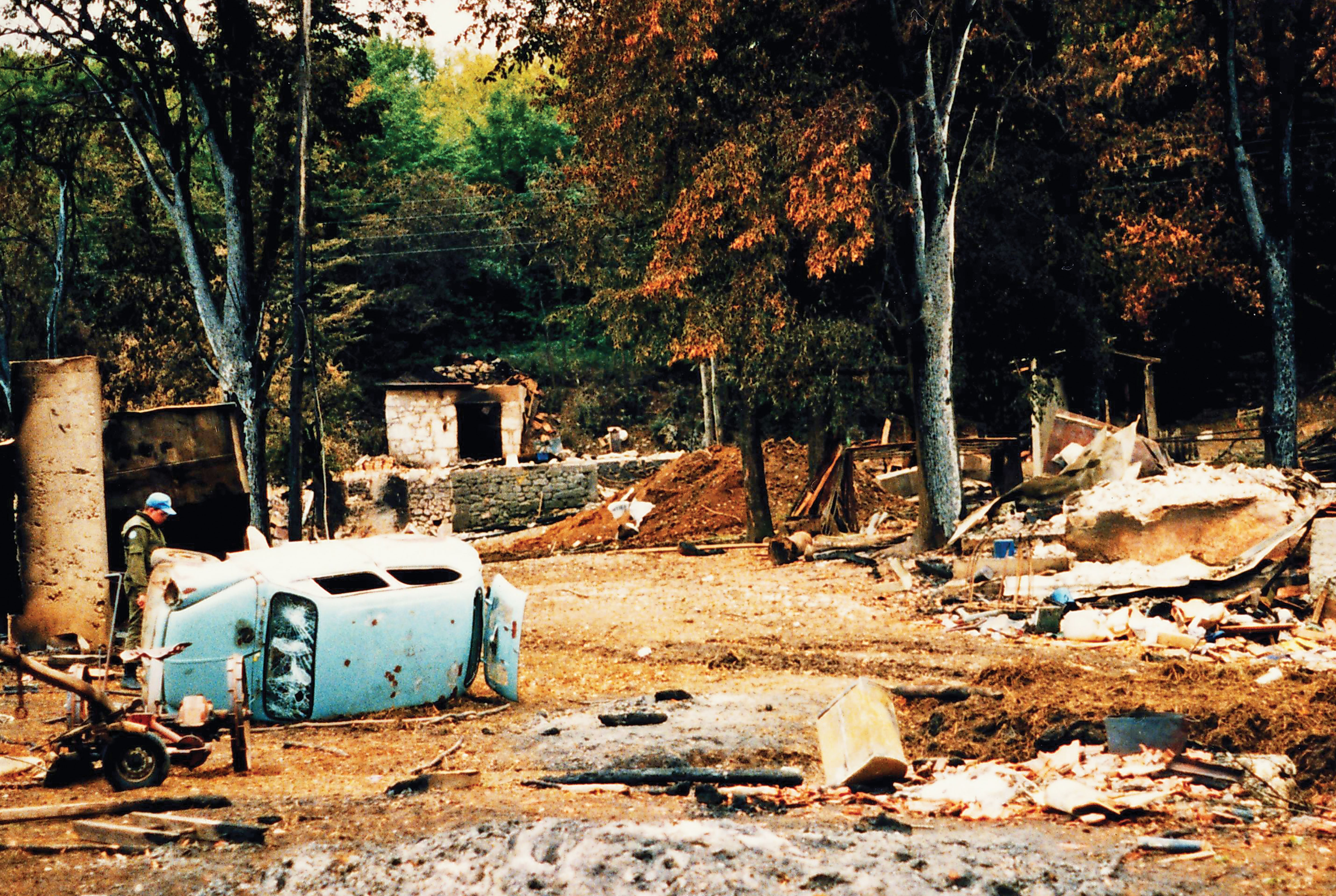
A UN soldier surveys the damage in the town of Medak after the battle in September 1993. Every house and hut was blown up and many of the ruins were left booby-trapped by Croatian troops. [Master Corporal Phil Tobicoe/PPCLI Archives/20.39.06]
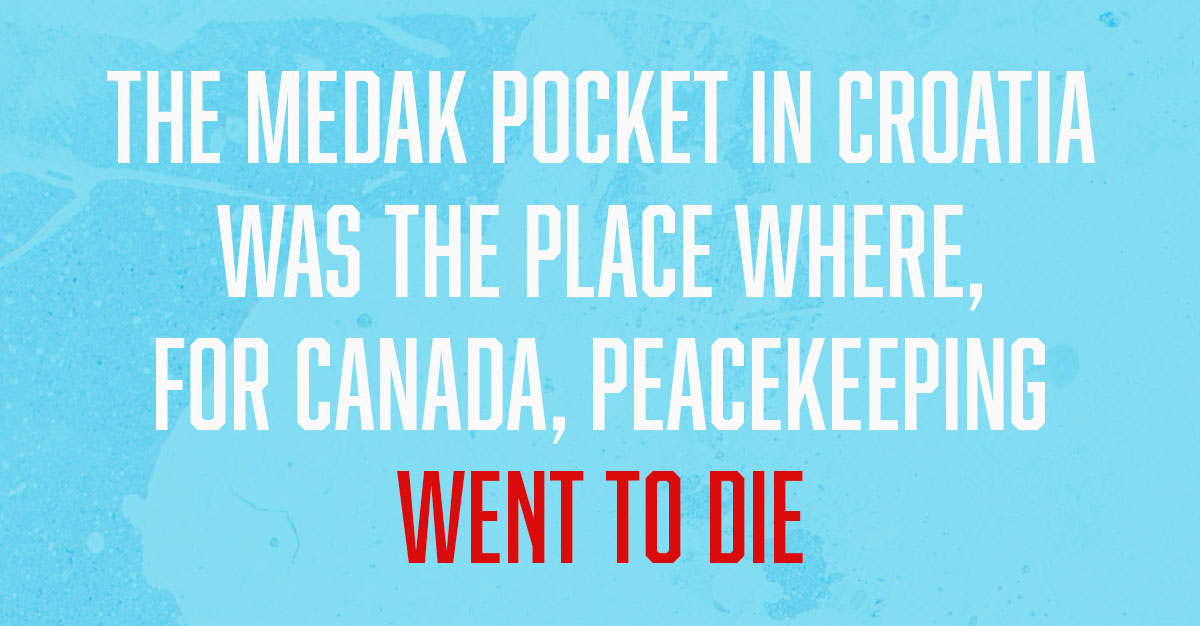
For Dan Drew and the other Canadians who fought in Croatia over those few days in September 1993, the salient dividing Serb and Croation forces became “Canada’s Vietnam”—an obscure battle that for years went unrecognized, its soldiers unthanked, its scars unhealed.
Four Canadians were wounded during the fierce and protracted confrontation. Many of the 875 reservists and regulars from 2nd Battalion, Princess Patricia’s Canadian Light Infantry (2PPCLI) suffered and still suffer consequences.
Those consequences—undiagnosed post-traumatic stress disorder and a rash of suicides, disproportionate even by military standards—came not just of the fighting but also of the aftermath, both in the ethnic cleansing they couldn’t stop and the welcome home they never got.
Drew was an acting major at the time, commanding a patchwork company made up of 80 per cent reservists. The bulk of his charges had minimal training and virtually no overseas experience. They were young and wide-eyed and they came from Newfoundland and British Columbia and almost every point in between.
“We all came home under a cloud and, in the case of the militia guys, they were all thrown to the four winds and nobody knew what they’d been through,” recalls Drew, a plain-speaking fighting man who retired a lieutenant-colonel in 2012 after five eventful overseas tours, two in Afghanistan.
“So, we had a real significant incidence of PTSD and a high suicide rate. There was nothing in place to help them; they had nowhere to go, no one to talk to.”
They’d been to what was once a part of Yugoslavia, where for decades Josip Broz Tito, its Second World War hero and widely respected president, had ruled with a benevolent kind of iron fist.
It was Tito who said that no one in postwar Yugoslavia “questioned who is a Serb, who is a Croat, who is a Muslim (Bosniak); we were all one people.” His death in 1980 was a harbinger for what was to come.
Within a decade, communist governments across the Soviet sphere fell like dominoes. Yugoslavia dissolved into ethnic hatred, murder and war (see page 88). Its territorial spawn—places such as Croatia, Kosovo and Bosnia—came to symbolize suffering and war crimes unlike anything known to Europe since 1945, right down to the emaciated prisoners of concentration camps, where thousands of Croats and Bosniaks died by Serb hands.
It wasn’t just Bosnia. In Croatia and Kosovo, too, entire villages were wiped out. Women were raped, men tortured, homes burned, property booby-trapped. Wells were poisoned and crops destroyed. Cattle were slaughtered in the fields. Atrocities were committed by all sides.

UN peacekeepers display confiscated weapons in Croatia in August 1993. [Master Corporal Phil Tobicoe/PPCLI Archives]
For a generation of baby boomers who grew up looking the other way, or protesting an escalating, unpopular war in Vietnam, the bloodbath in Eastern Europe was an eye-opening end to the Cold War era. During that half-century, the Iron Curtain shielded and contained a long and tragic history of ethnic hatred that had, it turned out, only been reduced to a simmering stew just waiting to boil over.
Between 1992 and 2002, Canada dispatched its military to every hotspot, usually in United Nations blue helmets (Kosovo was a NATO mission). But with no peace to keep, Canadian soldiers in the mountainous region known as the Balkans, stretching from the Serbian-Bulgarian border to the Black Sea, found themselves at odds with a cold and incomprehensible reality. The Balkans became etched in the Canadian psyche.
“In the Balkans, there was never any intention of resolving anything peacefully,” said Drew. “I think the UN was used essentially to give everybody time to make the preparations that they needed to achieve their desired end state which, in the case of Croatia, was an ethnically cleansed Croatia and the old borders re-established.”
More often than not, politics and a leadership void back home and in the UN itself, along with restrictive rules of engagement, often rendered the intervening forces an ineffectual presence as they tried to enforce a peace that neither side wanted.
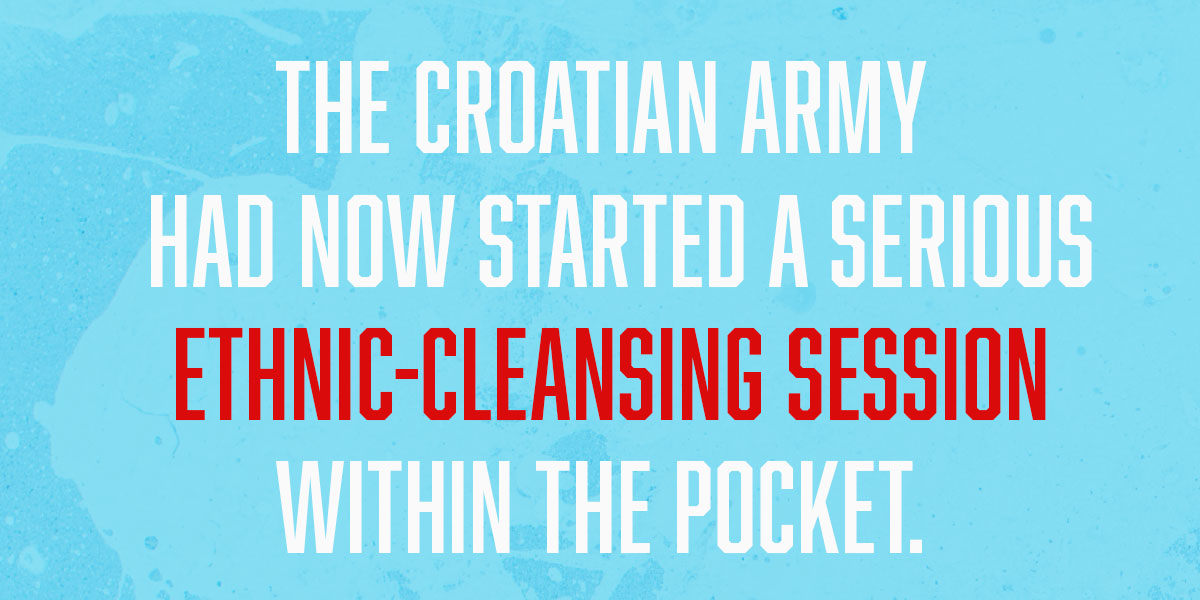
For many “peacekeepers,” it was like trying to do the job with one hand tied behind their backs. Or worse.
Peacekeeping had evolved considerably from the 1970s and 1980s, the force commander, Colonel Jim Calvin, told the House of Commons defence committee in 1998.
“By and large, we were into roles where there was an agreed peace agreement,” said Calvin. “The sides had agreed to stop fighting and we were…interposing ourselves between factions that were not firing back and forth on each other.… Certainly, the evolution of peacekeeping has become far more warlike. It’s caused us to have to have far more war skills when we deploy.”
Going into Croatia, however, 44 per cent of 2PPCLI was made up of reservists who received an average of only 44 days of training a year. “He’s nowhere near a regular force soldier,” said Calvin, explaining that regulars had to fill specialized roles the poorly trained reservists couldn’t.
The reservists, then, were riflemen destined for the front lines. Furthermore, seven of Calvin’s 12 platoon commanders were reservists.
The Canadians were initially deployed in an area of Croatia called Sector West, what Calvin characterized as a stable, traditional peacekeeping area where both sides were largely abiding by an agreement. Midway through 2PPCLI’s tour, however, the force commander, French Lieutenant-General Jean Cot, ordered Calvin to deploy half the battalion 550 kilometres south, near the Adriatic Sea.
“Sector South was a far more volatile and demanding sector,” said Calvin. “Open warfare was going on here. Artillery shelling was a daily occurrence.”
The depleted Canadian force was there for five weeks before the rest of the group was ordered south and much of the battalion was moved into even more volatile areas. The first troops had just arrived when things started going sideways.
“We weren’t stable in this position,” said Calvin. “We were very much getting used to the area and were trying to find our way.”
What confronted them was a situation unlike anything the reservists, particularly, could have imagined.
Up to 18,000 Serb soldiers, backed by the Yugoslav National Army, occupied demilitarized zones. Croats were determined to drive them out and cleanse the region of all Serbs, taking back the breakaway Republic of Serbian Krajina.
The area encompassed the Medak Pocket, a 30-square-kilometre bulge comprising villages and fertile farmland extending deep into official Croatian territory. The Serbs held the village of Medak itself, where the Canadians had taken up positions.
All hell broke loose on Sept. 9 with an artillery barrage throughout the length and breadth of the Canadian sector. Most of the artillery rounds were focused on the village, an area smaller than Parliament Hill. Holding the line and ordered to fire only if fired on, the Canadians could do little more than listen to gunshots, booming explosions and the screams of civilians.
“Five hundred and twenty-five rounds fell on the town of Medak in a 24-hour period,” said Calvin. “The reason we know is because the soldiers who were holed up in [an unfortified] house began recording the number of rounds.… When you have 500 rounds falling, four this time, five minutes later another three, over a 24-hour period, it tends to wear on one’s ability to withstand the stress.”
The Canadians were caught between the two sides, both of which considered them an obstacle and a nuisance. They came under machine-gun and mortar fire and encountered ambushes and booby traps as Croats attacked and Serbs counterattacked.
All the while, they knew civilians were dying and there was little they could do about it. They were pinned down.
“There were tremendous casualties inside the town of Medak,” said Calvin. “At one point, a woman came into the house that Lieutenant [Tyrone] Green was commanding. She was bleeding from the head.
“She said her house had just been struck by shellfire. Warrant Officer Trenholm went out and jumped into an armoured personnel carrier, while my [regimental sergeant-major] gave her basic first aid in the house. Warrant Trenholm went to pull her children out of the building and take them to a Serb bunker where they would be safe.”
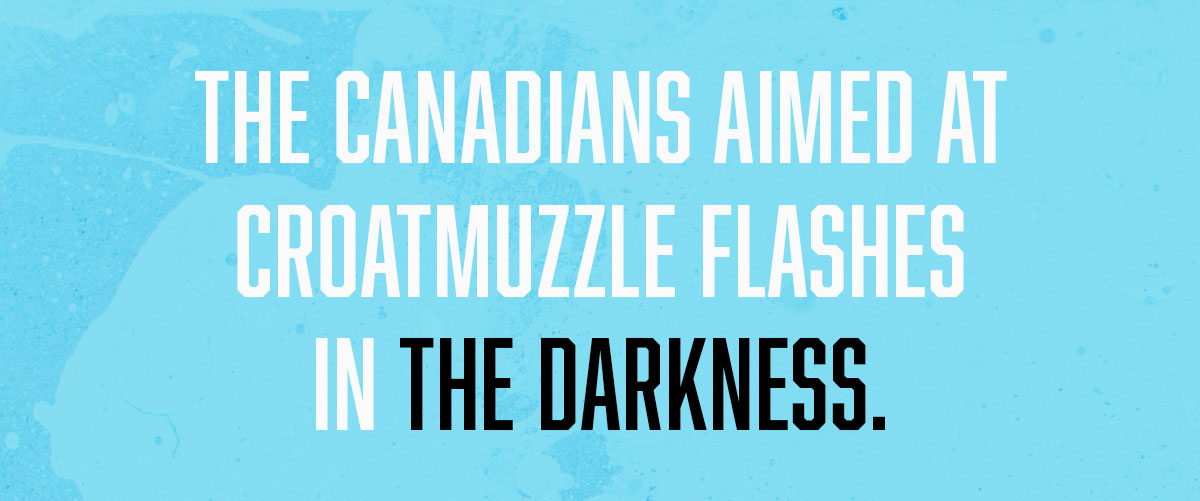
Two Canadians near the front were hit by shrapnel. Two others, 15 kilometres behind the lines, drove their supply truck into an artillery barrage, then were flanked by mortar fire. The front of their vehicle was shredded and they were both hit. None of the wounds was life-threatening.
The Croats started advancing in a pincer movement, with tanks and infantry coming from the north and dismounted special forces coming from the mountains in the south. The two sides waged war for the pocket for 36 to 48 hours.
Serb reserves arrived by the busload, along with tanks, artillery pieces and armoured personnel carriers. They stabilized a new front line and the fighting paused after three days. “Things stabilized and the political process kicked in to try to…bring a resolution to the area,” said Calvin.
Finally, after UN-mediated talks in the Croatian capital of Zagreb, both parties agreed to return to their previous lines. The UN commander, Cot, ordered the Canadians to move in, place themselves between the warring parties, and push them back.
The order exceeded the Canadians’ mandate. They had no air or armoured support and they were badly outgunned. Under the rules of engagement, the firm-handed Calvin could have said no. He didn’t.
“We established our zone of separation and enforced the rules that were given to us,” said Drew, describing how patrols intercepted raiding parties from both sides, disarmed them and turned them over to authorities. The raids quickly stopped.
“We probably did it more aggressively than the rules they gave us, but we had an understanding of what was right and what was wrong and we did the right thing rather than what was the strictly legal thing.”
Calvin was given two French companies, about 250-strong. He now had about 1,000 troops at his disposal. Before the operation began, Cot told Calvin that the UN “had lost face in the past and it was critical that we show that we could actually enforce our will and make this buffer zone work.” Then he gave Calvin some sobering news: he said he didn’t believe the Croatian high command had told its front-line soldiers that they were required to withdraw.
“You can imagine what that felt like to us,” said Calvin, “knowing that we were now going to move from behind the Serb front lines…toward a warring faction that didn’t know that they were being ordered by their high command to withdraw.”
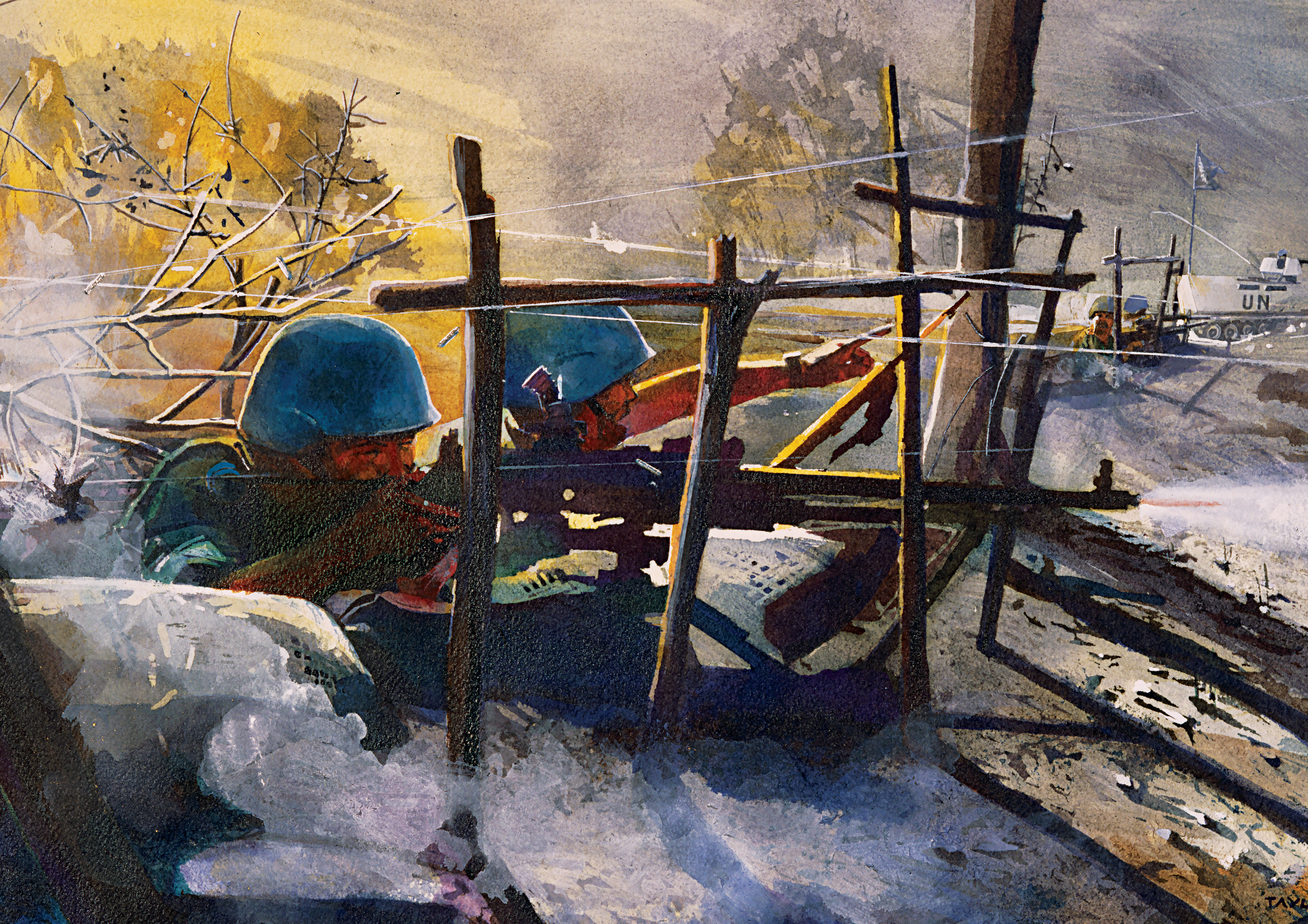
“Firefight in the Medak Pocket” by Katherine Taylor depicts regular and reserve soldiers of 2nd Battalion, Princess Patricia’s Canadian Light Infantry, along with French troops, holding the line in a firefight against a larger Croatian force in September 1993. [Katherine Taylor]
At noon on Sept. 15, 2PPCLI’s ‘C’ Company began advancing from the left while a French company moved from the right, past the Serb tanks and infantry and into the zone between the two front lines.
“The terrain that was in between them was what we normally refer to as a killing zone, and that was the area into which we were moving the Canadians and the French,” said Calvin. “When we passed by the Serb front lines, we started being fired on by the Croatians. Initially, it was one round, two rounds.
“We honestly thought it was a mistake, and we gave direction to put bigger UN flags on our antennas and make sure the white vehicles were prevalent so that they would know who was moving into the no man’s land. When we did that, they started firing machine guns at us instead of single rounds, and it became evident that this was not an accident but actually a concentrated attempt to fire at the United Nations.”
The Canadian and French responded in kind and, for the next 19 hours, between roughly 1 p.m. and 8:30 a.m. the next day, they exchanged fire with the Croatian army at ranges of 150 to 800 metres.
The platoon on the far left, commanded by Captain Dave McKillop in the town of Čitluk, was in five separate firefights, some lasting five minutes, some more than an hour.
“They were fired on by 20-millimetre cannon, heavy machine guns, rocket-propelled grenades,” said Calvin, “and they responded with all of the inventory they had: .50-calibre machine guns, their own C7s, C9 machine guns.”
The Canadians aimed at Croat muzzle flashes in the darkness. As the fury subsided, the telltale cracks of single shots pierced the air. Later that day, the Croat general summoned Calvin for an 8 p.m. conference in Gospic.
“This was a bit awkward because darkness fell at around 6 p.m. and at 19:30 hours we then had to find a way to get across from the Serb side, where we were, to the Croat side, which had been firing at us all day long, without getting ourselves shot.”
At 7:30, Calvin, Drew and two others began the long walk across the paved road toward the Croatians. Machine guns were firing in the distance.
“It was a bit of an interesting walk in the darkness, but literally we were in a situation where the lead man—not myself I might say—had a red flashlight and was actually giving three flashlight bursts toward the Croatians so that we could sit there and they could tell that we were the friendly people coming across and that they weren’t supposed to fire at us.
“We just had to go on good faith that they had got the word out to their soldiers this time that they weren’t supposed to take aim at the red flashlight.”
They made it and proceeded to what would turn out to be “a very heated meeting” with the Croatian army commander in Gospic.
“After an exchange of words between myself and the Croat commander about why he was firing at my soldiers for the last six or seven hours, we finally came to an accord where he would permit us to establish the crossing site that night.” The UN troops were to move into Croat positions the next day at noon.
When they arose at first light and surveyed the situation, however, they realized they had made what Calvin described as “a tragic error.”
“As we looked out over the kilometre that separated us from the Croatians, we could see nothing but billowing smoke starting to go up from every one of the villages that we could plot on our maps,” he said. “We started hearing large explosions and we started hearing small-arms fire coming from all over the villages within the pocket itself.
“It was clear to us…that the Croatian army had now started a serious ethnic-cleansing session within the pocket, and we were required to sit there and watch for four hours, until noon, before we could actually move to the other side.”
For the Canucks, who had fought so hard, it was frustrating, heartbreaking and demoralizing. They were up against what Calvin described as “thugs with guns.”
“They are not professional soldiers,” he said. “Professional soldiers don’t wage war on innocent civilians, but over there it was a matter of routine.”
At noon sharp, Drew’s company started moving forward to assume the Croat front lines. What they found when they got to the other side stopped them dead in their tracks. During the night, the Croatian army had moved a company defensive position, a T-72 tank, and several anti-armour missile systems onto the high ground behind Drew’s armoured personnel carriers. More than 100 soldiers had dug in ready to stop the advance.
“They had put mines on both sides of the one paved road and they had put the dragon-teeth barriers across the road and mines surface-laid on the pavement,” said Calvin. “When we got to the other side they said we couldn’t pass.
“This caught us very much unawares. We were basically lined up expecting the agreement we’d reached to be followed to the letter. We were in the killing zone of this particular company so we were very mal-positioned.”
It was a standoff for 90 minutes while Calvin argued with the Croat general across a minefield.
“At one point, we said we were going to go through by force,” said Calvin. “They manned all of their weapons, all of my soldiers cocked all of their weapons.
“Master Warrant Officer [Jim] Butters started moving the weapons systems through the minefields and getting them into position so they could engage and cover us if a firefight broke out. For over an hour, we were in perhaps what was just an extraordinarily tense situation.”
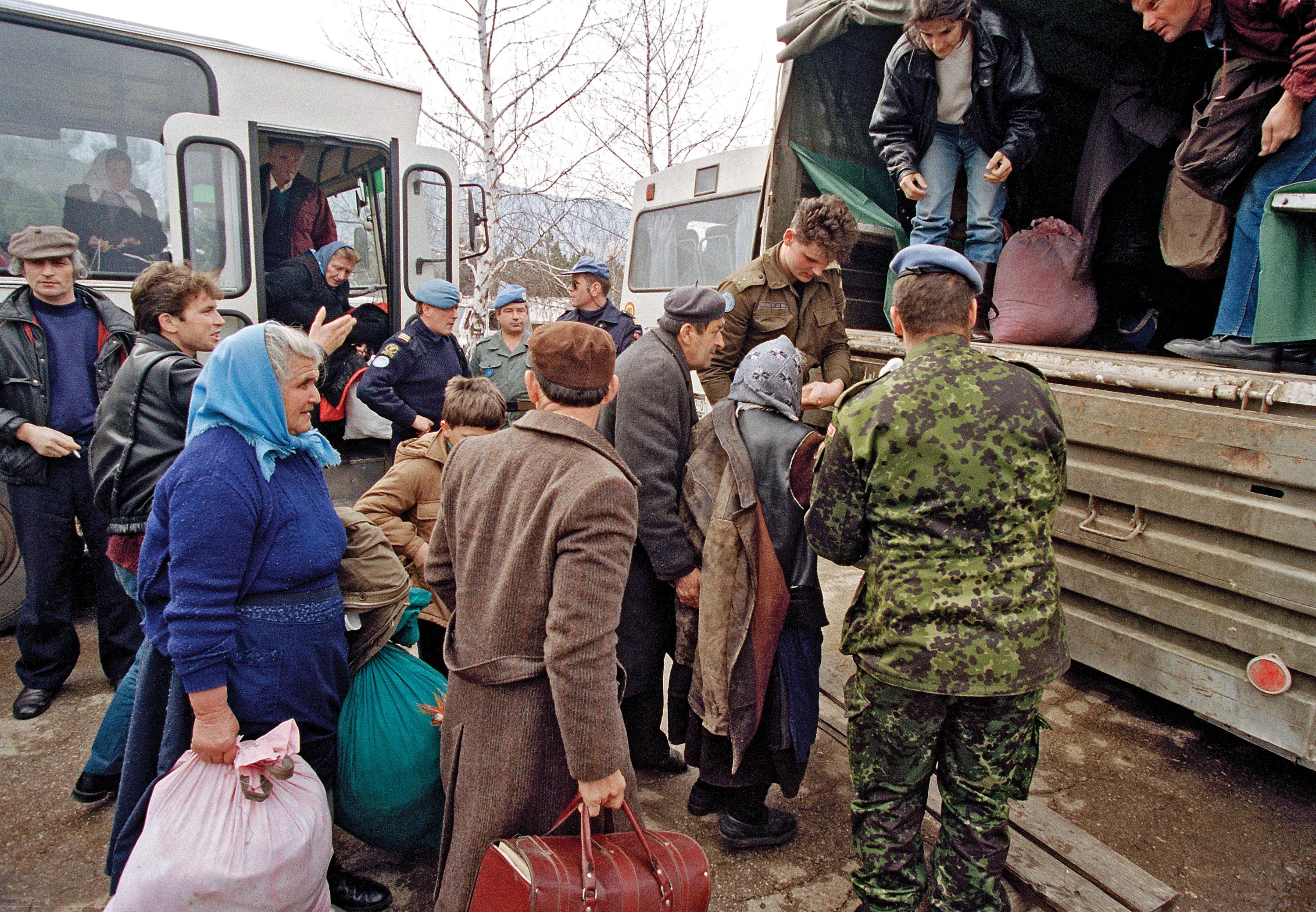
Ethnic Croatians who have been displaced from their homes are helped onto the back of a truck belonging to the UN Protection Force as they are evacuated from Serb-occupied territory in March 1993. [UN Photo/M. Grafman/46583]
What saved them? Twenty reporters and cameramen showed up expecting to come through with the Canadians and record the battle’s aftermath.
“They were all huddled behind one of the armoured personnel carriers in case all hell broke loose,” said Calvin. “And I came up with the idea this wasn’t the time to say ‘charge.’ This was time to use the indirect approach.
“So, I went to [the media] and I asked if we could stage a press conference in front of the minefield so that I could jeopardize the Croatians’ reputation on the international front and accuse them of bad things and try to get them to lift the minefields and to let us through.”
Speaking in English, Calvin accused the Croat general of atrocities.
“When he heard what I was saying to the international press, he soon had soldiers out clearing the minefields and he renegotiated the agreement to allow us to pass by. Then he gave an impromptu press conference right then to try to… regain the moral high ground.”
The Canadians were through. Soon after, they began finding evidence of ethnic cleansing. In the village of Čitluk, buildings were still burning and Croatian soldiers with bags of loot were jumping on trucks and buses, laughing as they left.
The Canadians also started finding bodies. French troops found two women between the ages of 16 and 25 who had been held prisoner for days by the Croatian army in a farmhouse.
“They must have been shot and set on fire just before the Croatians moved back,” said Calvin, “because when we actually found them, the bodies were so hot that before they could be put in the body bags, the soldiers had to douse them with water to cool them down so they wouldn’t melt the plastic of the body bags.”
Livestock had been killed. Wells had been poisoned with oil or animals. The whole area had been mined. “In the broadest sense of ethnic cleansing, they had made sure that the people who had lived there could not return to that area, either by killing them, by destroying their property, or by poisoning their wells.”
The UN troops found 16 bodies. There were surgical gloves scattered everywhere. “We couldn’t figure out any other reason for the Croats to leave surgical gloves all over the ground, other than the fact that they had a systematic method of picking up the bodies that we didn’t find and clearing them out before we actually got in there. And it might have been the reason why they were delaying us at the actual roadblock.”
When the mission ended, the casualty tally included four Canadians and seven French soldiers wounded by artillery or mines, plus one Canadian, Captain Jim Decoste, killed and two more severely injured when their jeep ran into a Serb truck. Another Canadian, Corporal John Béchard, was killed earlier in the mission when a truck slipped off its chock and crushed him. As many as 27 Croats were killed and more were wounded during the firefights with Canadians.
“It is clear in my mind that when we send people over to some of these missions, we have to expect them to be bold and expect them to make the decisions on the ground that they have to make,” said Calvin. “We can’t send them over to be hesitant and to think we’re going to second-guess them all the time.”
The Canadians returned home under a cloud. Senior military leadership of the day, more bureaucrat than seasoned soldier, “was so disconnected from what was happening on the ground that they didn’t have any idea” what their troops had been through, said Drew. “And they really didn’t care, to be honest with you. That’s the feeling I got. They just didn’t get it. They didn’t want to know about it.
“And the fact that we had killed a bunch of Croats in that area, to a lot of these bureaucrats it was like, ‘Oh my God, how can Canadian soldiers do this?’ They were actually ashamed that Canadian soldiers had killed people in the conduct of their duties.”
The Somalia scandal was breaking. The military was entering what many consider the darkest period in its history, personified in the 1999 images of Canadian troops doing the menial work of shovelling snow on Toronto streets.
The military was the butt of public ridicule, ravaged by federal budget cuts, shamed by the torture and death of a Somali teenager, criticized for everything from the physical condition of its soldiers to the colour of its uniforms.
Many of its members, especially reservists, were suffering the effects of what was then an obscure and misunderstood disorder. All this while performing challenging, thankless tasks in failed and forgotten parts of the world.
Without adequate diagnosis and treatment, it wasn’t long before the post-mission casualties began to mount. Drew knows of at least five in his company of 130 troops who killed themselves after coming home.

Finally, with clear evidence that soldiers were struggling, the military called a board of inquiry in 1999, led by Col. Joe Sharpe. It interviewed more than 3,000 veterans of the Balkans missions. The leadership void was a common thread in testimony.
“Many were self-medicating, were alcoholics, and [the Canadian Forces] threw the book at them, dishonourable discharges and everything,” Sharpe told the Toronto Star in 2013. “There was absolutely no attempt to understand them.”
It took a decade for the Medak Pocket to be publicly acknowledged as Canada’s most significant fighting since the Korean War. In 2002, as public recognition for the role Canadians were filling in Afghanistan took hold, then-governor general Adrienne Clarkson awarded 2PPCLI the Commander-in-Chief Unit Commendation.
“For courageous and professional execution of duty during the Medak Pocket Operation,” said the citation. “Under conditions of extreme peril and hazard, facing enemy artillery, small arms and heavy machine-gun fire as well as anti-tank and anti-personnel mines, the members of the 2PPCLI BG [battle group] held their ground and drove the Croatian forces back.
“The exemplary action of the 2PPCLI BG caused the Croatian Army to cease their ongoing tactics of ‘ethnic cleansing’ in the sector, without question saving many innocent civilian lives.”
Several soldiers received individual medals after the engagement. The battalion was also awarded a rare UN Force Commander’s Commendation.
Back in the public eye at last, the Canadian military’s visibility, credibility and appreciation rose ever-higher as the Afghanistan mission evolved and the list of dead and wounded grew longer.
Prevention, diagnosis and treatment of PTSD, while still evolving, improved. But for many, it was too late. There were suicides. Marriages collapsed. Calvin, once considered a surefire bet for general, never made it past the rank of colonel. And for untold numbers of Serbs in Croatia, it was the end.
“UN operations don’t work—we proved it,” said Drew. “At the end of the day, the Croats got exactly what they wanted. They ethnically cleansed all of Croatia. The UN operation, writ large in Yugoslavia, was nothing but a witness to slaughter.”
Advertisement




















